32: The Not-So-Minor Cardmakers of the 19th Century - Part 3
A survey of the cards made by Creswick and Hardy, with a brief mention of De La Rue, Goodall and Reynolds.
CRESWICK
Thomas Creswick’s father, James, was a stationer and paper maker back in the closing years of the 18th century. It is not until 1820 that the first Garter AS in the name of Thomas Creswick was issued. It is quite surprising, therefore, that his output was as high as 39,160 in 1824, the second largest output in that year for the home market. In 1824 both Thomas and his brother, William, have separate stationer's businesses, though William, even though he is a papermaker, does not make cards. Up until just before 1820 papermakers were not allowed to be card-makers as well, and Thomas Creswick told the Revenue Commission of 1825 that he had produced cards through a front man. I suggest that this was Josiah Stone, since around 1825 Creswick had 5,000 Stone export aces reassigned to him by the Tax Office. He seems to have closed down Stone's business and used his courts (Type II with elongated faces) in some packs or packs have CR1 courts with Type II red jacks. For most of his packs from 1820 Creswick seems to have redrawn his court figures in his own style (CR1), which don't seem to have been used by anyone else. These courts are found with both Garter and Frizzle aces. The red jacks, which were usually printed using a separate block (2 jacks x 5), are of Type III, the kind used in particular by Reynolds. I have never seen red jacks that are consistent with the style of CR1.
For a list of Creswick cards in my collection, click here►

Above: Type III red jacks

Above: Type II red jacks in the style of Stone
Most of his cards are of this type, but he also produced a non-standard pack called Imperial and redrew his standard courts in a less stylized way - see page 19►
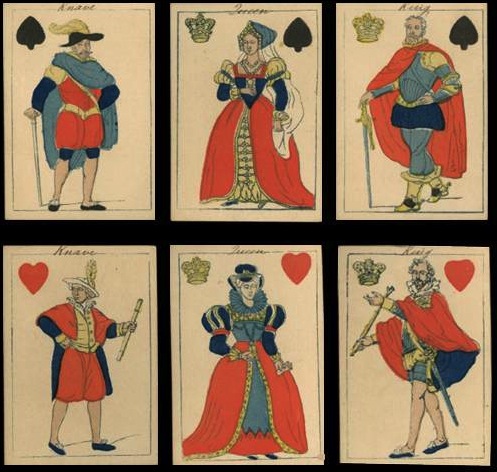
Above: Imperial cards
He also published a non-standard pack called New Costume Cards in c.1830, in which naturalistic courts look continental in style.

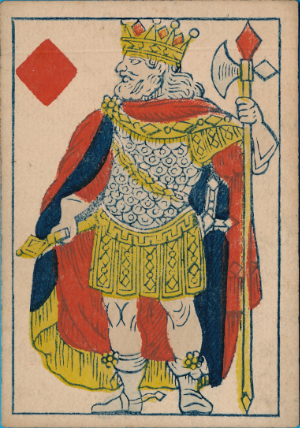
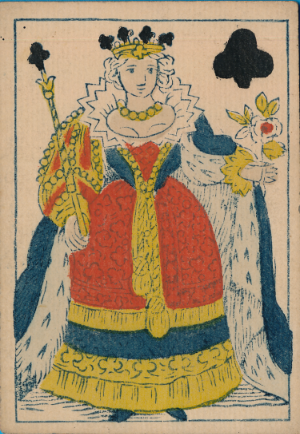

The redrawn version of the standard courts, which seems to fit with these other two packs, is referred to in a review in the Journal of Belles Lettres from 1827 (though this could refer to either of the non-standard packs, too):


Thomas died in 1840 and his son-in-law took over the business. He had little interest in it and the business was closed down in 1843 and the factories sold off. Packs with a Thomas Creswick Old Frizzle were probably still being sold off in the mid-1840s. But there are two more examples that possibly belong to this maker, although the Old Frizzle with the single-figure one is anonymous and the other has no AS, as it is a 'damaged' pack (another tax dodge) - see page 15►

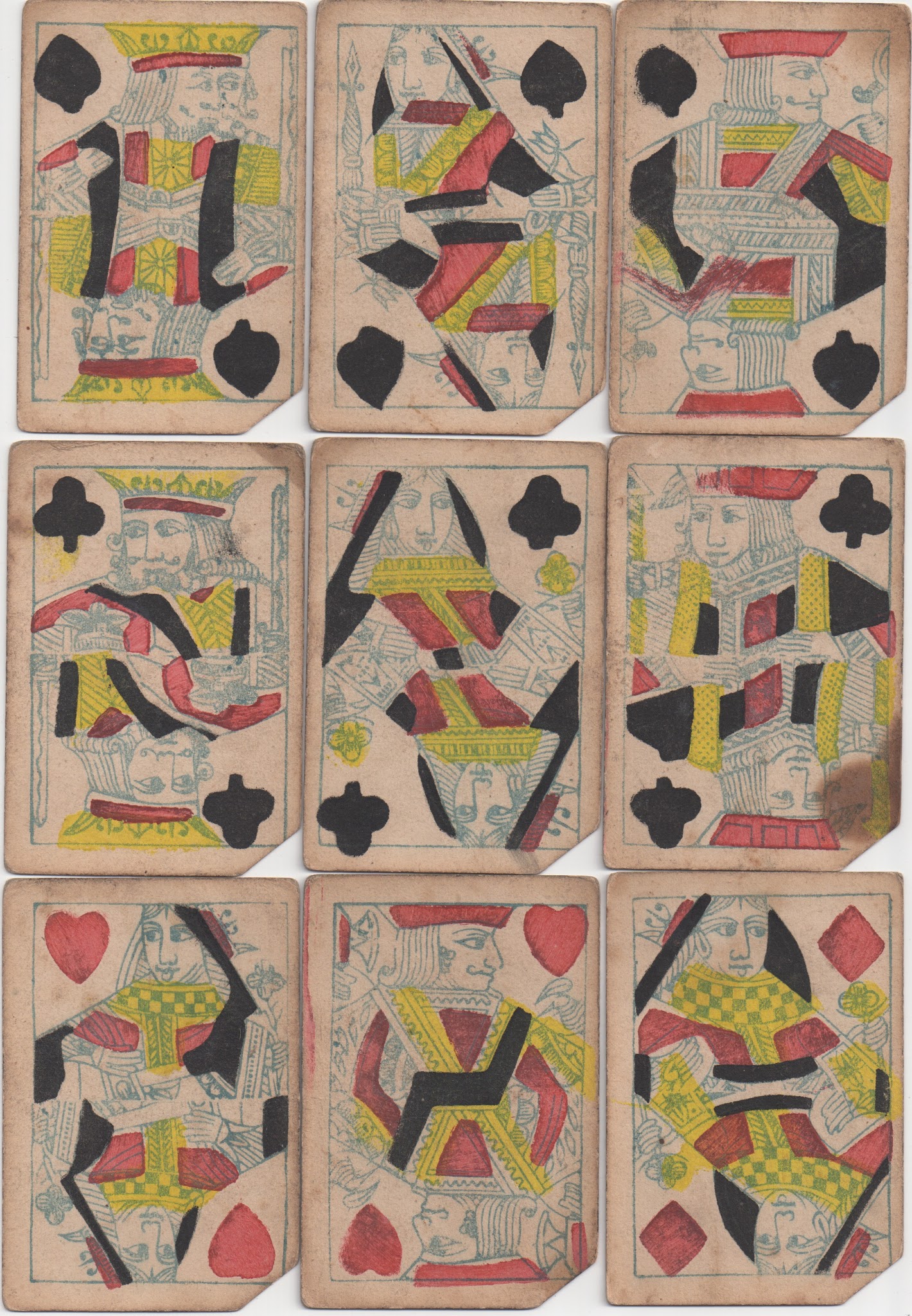
Above: Whoever made these, they represent poor production materials, but they are copies of the CR1 courts/Type III red jacks pictured above, and this design was only used by Creswick, as far as I know.
HARDY
The smallest of the firms in terms of production levels, but a long-lasting one nevertheless. The second son of an earlier cardmaking Hardy, James started his business in 1798, when that of his mother and older brother was near bankruptcy. Hardy & Sons continued in business until 1853. (Again, he doesn't figure in the De La Rue sheet.)
For a list of my Hardy packs, click here►
His first courts were of Type I with characteristics that are specific to him: the droopy moustache on the JS, the toothless-looking mouth of the JH, the single line for the mouth of the KD with his beard attached directly onto it, and for the non-profile courts the lips are very curly in comparison with similar courts by Hunt, for example.

Above: c.1800-25
At some point around the introduction of Old Frizzle or just before he used Type III courts, like those of Reynolds. A number of makers at this time went over to Type III courts, including Henry Wheeler, Turnbull, Woolley & Sabine and Stopforth, but I don't know whether this indicates that a new block-maker came on the scene around this time to supply them.

Above: Type III courts
But Hardy soon redrew his courts, based on Type III, with curlier hair drawn as single lines and single-line moustaches. These are only found in Hardy packs.

Above: Type IIIa/HD1
There is also an unusual version of the courts, which have a different style of drawing, which doesn't look English. These are found with Old Frizzle.


A most unusual product, imported by Hardy from France, was a double-ended pack of the standard Paris pattern by Dumoutier of Nantes, sold with an Old Frizzle AS.

There is even a double-ended version of Type IIIa, which must have been produced towards the end of the firm's activity.

Also at the end of the firm's activity is quite a different type of pack. In this case the cards are by Van Genechten, from the same plates as a pack imported by Ansell, but with a Hardy Old Frizzle. Maybe this was an attempt to modernize the look of his cards.

Above: thanks to Paul Symons for the image.
DE LA RUE, GOODALL and REYNOLDS, the big players of the 1850s have all been dealt with in some detail in many places (see page 5 on De La Rue, page 12 on Goodall and page 50 for Reynolds), but here is a glimpse of some of their early packs.

Above: De La Rue's first design (D1), which was submitted for his patent along with the more traditional style, based on Type III (D2).

Above: Goodall's second redrawing (G2) from the 1850s, though it has been found with a post-Frizzle AS. The KS has had the position of his head changed and the KD has lost a hand.

Above: Reynolds' first courts were of Type I, not surprising, as he was apprenticed to Hunt. These courts can be found with both Garter and Old Frizzle aces (c.1809-30).
And as a finale, here are four courts from Reynolds' North German pack (from the Cuming Museum).


AN EXCURSUS ON TAKE-OVERS AND MERGERS
For a timeline presentation of English card-makers 1761-1905, see page 20. Below is a simple extraction from the data of the name changes, take-overs and mergers that occurred throughout the period. A question mark indicates uncertainty, where a take-over of the premises is involved.
Durrance > Yates & Barnes, 1763? > 1776
Blanchard > James Gibson, 1770 > Charles Gibson, 1772 > Gibson & Gisborne, 1772 > Matthew Gibson, 1798 > Gibson & Hunt, 1801* > Hunt & Son, 1805 > Hunt & Sons, 1820 > Hunt, Hall, Bancks & Sons, 1840** > Bancks Brothers, 1849 > 1890
*Hunt, 1790 - 1801
**Sharp > McEvoy (date?) > Llewellyn, 1777? > Hall, 1786 > Hall & Son, 1799 > Hall & Bancks, 1820 > 1840
Brotherton, 1789 > Brotherton & Whitaker, 1826 > Whitaker, 1829 > 1862
James Hardy, 1798 > Hardy & Son, 1824 > Hardy & Sons, 1828 > 1853
Joseph Reynolds, 1809 > Reynolds & Sons, 1828 > Reynolds & Co [Goodall], 1883 > 1902?
In 1844 Woolley takes over Stopforth's address, though the latter ceased in 1838.
By Ken Lodge
United Kingdom • Member since May 14, 2012 • Contact
I'm Ken Lodge and have been collecting playing cards since I was about eighteen months old (1945). I am also a trained academic, so I can observe and analyze reasonably well. I've applied these analytical techniques over a long period of time to the study of playing cards and have managed to assemble a large amount of information about them, especially those of the standard English pattern. About Ken Lodge →

Related Articles
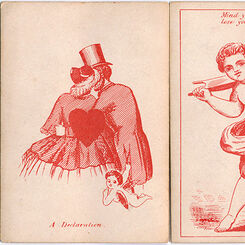
Fortune-Telling Cards
Comic Fortune-Telling Cards published by Reynolds & Sons, c.1850.
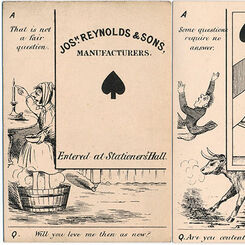
Comic Question & Answer cards
Comic Question & Answer cards by Josh. Reynolds & Sons, circa 1850.

69: My Collection
This is an archive list of my collection. I hope it will be of use and interest to others.

I. Hardy facsimile
Facsimile edition of 19th century I. Hardy Exportation deck complete with reproduction tax wrapper, ...

50: Joseph Reynolds
A presentation of my database of Reynolds cards.
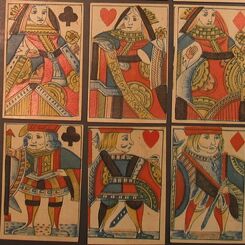
46: Henry Hardy, Henry French & Christopher Groser
A brief look at some makers of whom we know little.

39: Mixed Packs
A number of mixed packs appear for sale from time to time, but it's important to sort out what is me...

35: More Design Copies
Here I want to take another widely copied design and see how individual variation by the copier can ...

30: The Not-So-Minor Cardmakers of the 19th Century - Gibson, Hunt & Bancks
A preliminary look at the card-makers operating in the 19th century.

29: James English
An overview of the courts and aces of spades produced by James English
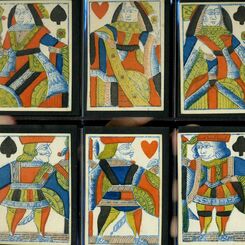
20: English Card-Makers 1761-1905
An initial survey of 19th century playing-card production. More detailed information appears on othe...

5: De La Rue
In December 1831 Thomas de la Rue was granted his patent for printing playing cards by letterpress.
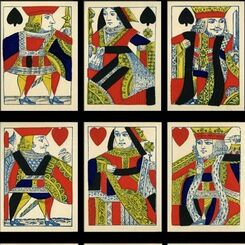
2: Still Collecting Playing Cards at 80
This is a personal account of some of my experiences collecting playing cards.

Hardy
The Hardy family of playing card manufacturers began with Henry Hardy (1784-89) and continued throug...
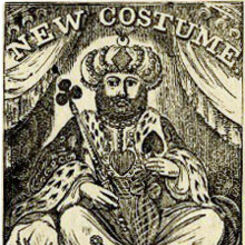
Thomas Creswick
Thomas Creswick was a paper-maker and wholesale stationer. Playing cards were produced from c.1820 o...

Reynolds c.1830
Woodblock and stencil playing cards, produced by Reynolds & Sons c.1830-1850.

Reynolds non-standard
Sometime around c.1850 Reynolds & Sons produced this non-standard or variant pack with courts inspir...
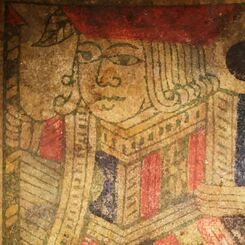
Reynolds c.1809-1885
Joseph Reynolds had been producing playing cards in the traditional method since c.1809.
Most Popular
Our top articles from the past 60 days
























